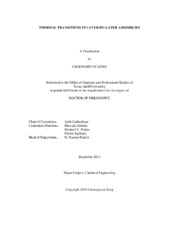| dc.description.abstract | Thermal transitions in layer-by-layer (LbL) assemblies were investigated under dry and hydrated conditions. In the dry state, the effects of film thickness and the film deposition method on the glass transition temperature (Tg) were studied. In aqueous conditions, the thermal behavior of microtubes and ultrathin films were studied.
The effect of film thickness on the Tg for poly(ethylene oxide)/poly(acrylic acid) (PEO/PAA) and PEO/poly(methacrylic acid) (PMAA) hydrogen-bonded LbL assemblies was investigated in the dry state. The Tg of PEO/PAA LbL films increased by 9 °C as the thickness decreased from 150 nm to 30 nm. In contrast, the Tg of thermally crosslinked PEO/PMAA LbL films was not influenced by film thickness.
The thermal properties of dry PEO/PAA and PEO/PMAA LbL assemblies prepared using dip- and spray-assisted methods were compared. For both LbL assemblies, Tg’s were similar regardless of deposition method. However, the breadth of glass transition was larger for the spray-assisted films. While PEO/PAA LbL assemblies showed smooth surface morphologies regardless of the deposition method, PEO/PMAA LbL assemblies showed different surface morphologies depending on the deposition method.
The temperature-triggered transformation of LbL microtubes consisting of poly(allylamine hydrochloride) (PAH) and poly(acrylic acid) (PAA) was studied in aqueous media. LbL microtubes were assembled from sacrificial porous membranes.
Released microtubes became spherical and ellipsoidal upon high temperature incubation. In comparison, unreleased microtubes exhibited periodic perforations.
The thermal transition of LbL assemblies of poly(diallyldimethylammonium chloride) (PDAC) and poly(styrene sulfonate) (PSS) was probed using electrochemical impedance spectroscopy (EIS). Two thermal transition temperatures were obtained from the plot of film resistance (Ttr,Rf) and the charge transfer resistance (Ttr,Rct) as a function of temperature. Below 20 layers, PSS-capped LbL films showed higher Ttr,Rct values compared to PDAC-capped films. In contrast, Ttr,Rf was largely uninfluenced by assembly parameters.
In conclusion, thermal transitions in dry LbL assemblies were influenced by the film thickness and film deposition method. Thermal behavior of LbL microtubes were linked to the thermal transitions in hydrated state. EIS study on thermal transitions provided unique information on the structure of LbL assemblies. | en |


